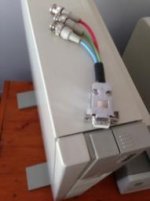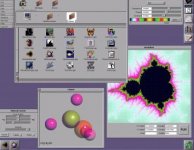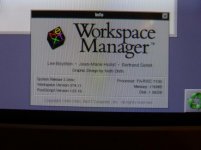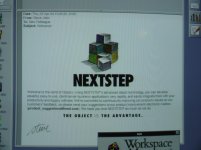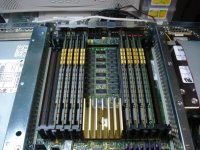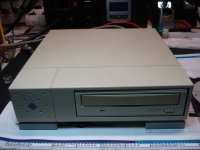jgavila
Member
Hi all,
I got an HP Apollo 735 some years ago as it was about to being tossed in the trash at my former workplace :shocked:. BTW, when I got it, I had no idea of what it was except it was an HP and looked like a nice unit
Well, one good thing is that I managed to get at same time several items which, later, I found that were part of the system: a couple HIL keyboards (one Spanish, one Englsh), a HIL mouse, some HIL cables and such. I din't get a monitor, though.
Yesterday I decided it was the day to get back to life the HP Apollo 735. So I took it from storage. I had it for about 4 or 5 years, but it had been on storage previously an unknown time. I guess it was unused for at least about 15 years.
So I took the cover off and then the inner metal cover, to find very dirty internals. And I mean very. Well, armed with a vacuum cleaner, some small and medium sized brushes, and lots of patience, I began getting all that crud out and dismantling the unit completely. It is interesting how well made are these units and how easy they are to disassemble. Great job, HP!
It was too late so, after reassembling it, I left for today the first power-ON test... I had set up a GBS-8200 V4 board to try to convert the video to a VGA monitor (my 735 has a GRX graphic card) and had also located a HIL keyboard and mouse (which were also got for free same time than the Apollo ). But I was missing a HIL cable, as it had been used on my HP-9000. I thought I had another one on my storage area, so I went for it. I left the unit powered OFF, but with the power cable already connected.
). But I was missing a HIL cable, as it had been used on my HP-9000. I thought I had another one on my storage area, so I went for it. I left the unit powered OFF, but with the power cable already connected.
In about 5 minutes, I was back to my main home building, and I noticed a burnt smell even from the lower floor :shocked: (my lab is on the upper floor). Rushing to it, I expected to find my lab on flames!. But, not, the protection system had triggered in, but the power supply on the 735 had thrown some brown stuff from the rear of the unit, to all the surrounding objects . And the smell was... terrible.
I know this kind of fault, as it has happened before twice, once on an HP item (an external HPIB HD/FDD combo) and once on a Philips counter. The culprit was a SCHAFFNER power line filter. It shorts inside and burns / boils until the power line protection triggers. I wonder if this is a common thing to happen and perhaps next time I will directly replace it, as it is a 4 EUR item which causes a big work, due to the messy substance spillage.
I had a similar unit, bought as spare for another project, so replacing it was just a matter of minutes (after an hour of cleaning!). Then I have powered the unit... and the power LED has flickered some times... and yet more fumes have erupted from inside the 735!. It seemed to me that they came from the PS assembly again, so I have opened it. But nothing seemed suspicious nor damaged on it.
Well, time to think... I have removed the hard disk tray to access the power switch and have carefully cleaned it with DeOxit, just in case there was a contact problem. Then I have tried again. But the power LED dimmly lighted for an split second on each power ON attempt. So something was preventing the PS to start. A shorted capacitor perhaps?
So I have removed the VIDEO board. All was OK. Then the I/O board over it... and there it was!. An SMD electrolytic had exploded!. It was a 33uF/16V unit, which I have replaced with a 33uF/35V/105C standard cap. Once I have put the assembly back, the unit has finally powered ON, done some things (according to the changing status LEDs), and end with an error, due to not finding a booting unit (the hard disk was still removed). Great!!! :D
I have not been able to get the video displayed on the VGA monitor. I get something, but sync is not working. On the HP-9000, I don't need to add any external device to sepparate SYNC and it works fine. It seems the video generated by the Apollo is different. Any hint regarding this?. Perhaps the cheap GBS-8200 is not the solution in this case.
I plan to add a page on my WEB depicting all this procedure and the future work on the Apollo, as I always took plenty of pictures of the works I do.
Best regards,
JOSE
PS: the lab still smells... funny
I got an HP Apollo 735 some years ago as it was about to being tossed in the trash at my former workplace :shocked:. BTW, when I got it, I had no idea of what it was except it was an HP and looked like a nice unit
Well, one good thing is that I managed to get at same time several items which, later, I found that were part of the system: a couple HIL keyboards (one Spanish, one Englsh), a HIL mouse, some HIL cables and such. I din't get a monitor, though.
Yesterday I decided it was the day to get back to life the HP Apollo 735. So I took it from storage. I had it for about 4 or 5 years, but it had been on storage previously an unknown time. I guess it was unused for at least about 15 years.
So I took the cover off and then the inner metal cover, to find very dirty internals. And I mean very. Well, armed with a vacuum cleaner, some small and medium sized brushes, and lots of patience, I began getting all that crud out and dismantling the unit completely. It is interesting how well made are these units and how easy they are to disassemble. Great job, HP!
It was too late so, after reassembling it, I left for today the first power-ON test... I had set up a GBS-8200 V4 board to try to convert the video to a VGA monitor (my 735 has a GRX graphic card) and had also located a HIL keyboard and mouse (which were also got for free same time than the Apollo
In about 5 minutes, I was back to my main home building, and I noticed a burnt smell even from the lower floor :shocked: (my lab is on the upper floor). Rushing to it, I expected to find my lab on flames!. But, not, the protection system had triggered in, but the power supply on the 735 had thrown some brown stuff from the rear of the unit, to all the surrounding objects . And the smell was... terrible.
I know this kind of fault, as it has happened before twice, once on an HP item (an external HPIB HD/FDD combo) and once on a Philips counter. The culprit was a SCHAFFNER power line filter. It shorts inside and burns / boils until the power line protection triggers. I wonder if this is a common thing to happen and perhaps next time I will directly replace it, as it is a 4 EUR item which causes a big work, due to the messy substance spillage.
I had a similar unit, bought as spare for another project, so replacing it was just a matter of minutes (after an hour of cleaning!). Then I have powered the unit... and the power LED has flickered some times... and yet more fumes have erupted from inside the 735!. It seemed to me that they came from the PS assembly again, so I have opened it. But nothing seemed suspicious nor damaged on it.
Well, time to think... I have removed the hard disk tray to access the power switch and have carefully cleaned it with DeOxit, just in case there was a contact problem. Then I have tried again. But the power LED dimmly lighted for an split second on each power ON attempt. So something was preventing the PS to start. A shorted capacitor perhaps?
So I have removed the VIDEO board. All was OK. Then the I/O board over it... and there it was!. An SMD electrolytic had exploded!. It was a 33uF/16V unit, which I have replaced with a 33uF/35V/105C standard cap. Once I have put the assembly back, the unit has finally powered ON, done some things (according to the changing status LEDs), and end with an error, due to not finding a booting unit (the hard disk was still removed). Great!!! :D
I have not been able to get the video displayed on the VGA monitor. I get something, but sync is not working. On the HP-9000, I don't need to add any external device to sepparate SYNC and it works fine. It seems the video generated by the Apollo is different. Any hint regarding this?. Perhaps the cheap GBS-8200 is not the solution in this case.
I plan to add a page on my WEB depicting all this procedure and the future work on the Apollo, as I always took plenty of pictures of the works I do.
Best regards,
JOSE
PS: the lab still smells... funny

